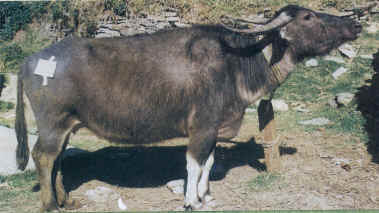|
|
|
Lime buffalo:

A Lime breed buffalo in the western hills (Photo by Dr. D.P. Rasali)
The pure breed Lime (pronounced as limè) is believed to have originated from wild
Arna (Bubalus arnii), and has been domesticated throughout the known
history of Nepal. They are found more towards the higher altitude of the hills
in the country. The Lime buffalo is estimated at 35% of the total indigenous buffalo population in the
hills and mountains of the country as calculated from the data from Rasali
(1998) and Rasali (2000).
Phenotypically,
the Lime buffalo are light brown and relatively small in body size, with
characteristic chevrons of gray or white hair below the jaws and around the brisket, and small sickle
shaped
horns curved towards the neck
(Rasali 1998).
Data averaged for adult females (n=96) are as follows :Body weight=399.1 kg; Height at wither=115.1; Body length =126.3 cm; Girth = 168.4;face length= 44.7 cm; Fore head width= 21.5 cm; Horn base circumference=20.6 cm Horn length= 46.2 cm. (Rasali et al., 1998b). Wither Height averaged 20 cm; Ear length averaged 20 cm; Average tail length is 82 cm (Pradhan et al, 1996).
Parkote buffalo:
A Parkote breed buffalo in Palpa district in the western hills.
Other Parkote buffalo (on the background)
wallowing in a village pond (Photo by Dr. D.P. Rasali)
Parkote buffalo are the typical buffalo of the mid
hill and river valleys of Nepal. However, due to traditional practice of
crossbreeding this breed with Lime buffalo and also due to recent crossbreeding
efforts with Indian Murrah, their population in pure form is declining. Now,
pure breed population is estimated at only 25 % of the indigenous population of
buffaloes in the hills and mountains in Nepal.
Phenotypically, the Parkote buffalo are dark in coat
color and medium built body size, with sword-shaped horns directed laterally or
towards the back of the body (Rasali, 1998; Pradhan et al.,
1996).
Biometrical data averaged for adult females (n=88) as as follows :Body weight=409.9 kg; Height at wither=114.9 cm; Body length =124.7 cm; Girth = 170.5 cm; face length= 44.6 cm; Fore head width= 21.2 cm; Horn base circumference=20.9 cm; Horn length= 46 cm. (Rasali et al., 1998).
References:
Pradhan, S.L., Sherchand, L.
and Shrestha, N.P. 1996. Policy and strategy for conservation of animal
genetic resources in Nepal. Department of
Livestock Services, Lalitpur, Nepal.